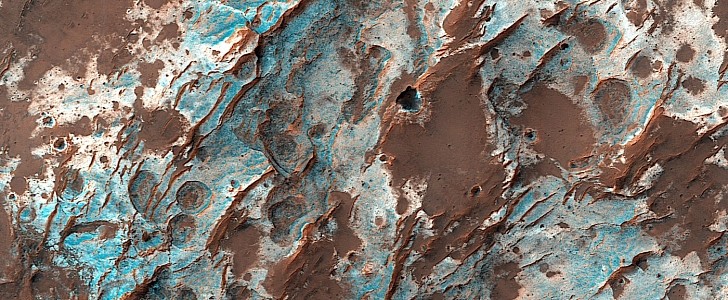Ever since the HiRISE camera got itself in orbit around the Red Planet onboard the Mars Reconnaissance Orbiter (MRO), humans have been treated with incredible images of the alien world.
Sure, it’s still an orbital camera we’re talking about, and that means there’s no hands-on approach to the study of the surface here, but the tens of thousands of images it sent back over the years, enhanced by various pieces of hardware and techniques, have painted a pretty solid picture of what humans might find if they ever get to Mars.
Scientific results aside, HiRISE is also fueling our imagination with the stills it sends back, as the human brain tries to make sense of what it’s seeing and comes up with the craziest of associations.
Take the image we have here. It shows a small portion of the Terra Sirenum region in the planet’s Southern Hemisphere, a place dotted with craters, but also the telltale signs of an active environment in the past.
Seen from an altitude of 257 km (160 miles), some of those impact craters, most of them visible a bit down and to the right of the image center, look to the non-scientific brain like some huge bullet holes in a massive wall.
The trained people studying the image however care little about these brain tricks. They’re more interested in the possible presence there of hydrated minerals, a clear sign that the planet could have once harbored not only liquid water, but probably even life in some form.
“What’s of interest here is the potential hydrated mineral signature that appears in CRISM multispectral data. Hydrated minerals on Mars are indicators of past environmental conditions,” scientists say about this image snapped all the way back in 2011, and recently released to the public.
“Comparing high-resolution images from HiRISE and the high spectral resolution of CRISM helps understand these minerals.”
Scientific results aside, HiRISE is also fueling our imagination with the stills it sends back, as the human brain tries to make sense of what it’s seeing and comes up with the craziest of associations.
Take the image we have here. It shows a small portion of the Terra Sirenum region in the planet’s Southern Hemisphere, a place dotted with craters, but also the telltale signs of an active environment in the past.
Seen from an altitude of 257 km (160 miles), some of those impact craters, most of them visible a bit down and to the right of the image center, look to the non-scientific brain like some huge bullet holes in a massive wall.
The trained people studying the image however care little about these brain tricks. They’re more interested in the possible presence there of hydrated minerals, a clear sign that the planet could have once harbored not only liquid water, but probably even life in some form.
“What’s of interest here is the potential hydrated mineral signature that appears in CRISM multispectral data. Hydrated minerals on Mars are indicators of past environmental conditions,” scientists say about this image snapped all the way back in 2011, and recently released to the public.
“Comparing high-resolution images from HiRISE and the high spectral resolution of CRISM helps understand these minerals.”






